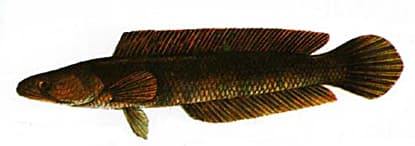Striped Snakehead – Channa Striata – Thai Fish Species
Species: Channa striata.
Common name: Striped Snakehead, Snakehead Murrel, Common Snakehead, and Chevron Snakehead. Thai Name: Pla Chon.
Distribution: Native to South and Southeast Asia, with a widespread range covering southern China, Thailand, Pakistan, most of India, Southern Nepal, Bangladesh and Sri Lanka. It has more recently been introduced to the outermost parts of Indonesia, the Philippines and Mauritius.
Habitat: Striped snakehead can be found in a variety of freshwater aquatic habitats. They are often found in slow-moving or standing freshwater bodies such as rivers, streams, and canals. They can also inhabit ponds, lakes, and reservoirs. During the monsoon season or when fields become flooded, they may venture into these temporary habitats to find food and shelter. In some regions, they may inhabit marshes and swamps, particularly if these areas are connected to larger water bodies. While they are primarily a freshwater species, some Striped Snakehead have been known to tolerate slightly brackish water conditions in estuaries and coastal areas. Striped snakehead are opportunistic predators and can adapt to various aquatic environments, but they tend to prefer areas with dense aquatic vegetation with ample hiding spots, among submerged roots and rocks. that offer ambush opportunities for hunting prey.
 Striped Snakehead (Channa striata)
Striped Snakehead (Channa striata)
This species is a member of the Snakehead family (Channidae). They are known for their distinctive appearance and behavior. They have an elongated, cylindrical body with an overall streamlined appearance. Typically, light in color with dark, vertical stripes running along their body, which gives them their common name. This species is known for their ability to tolerate low-oxygen environments by breathing air at the water’s surface, allowing them to survive in oxygen-deprived waters.
The Striped Snakehead is not currently listed as a threatened or endangered species and is generally considered of Least Concern by the International Union for Conservation of Nature (IUCN). However, they have become invasive in some regions where they have been introduced outside their native range, which can have negative ecological impacts. In summary, the Striped Snakehead is a unique freshwater fish species known for its distinctive appearance, predatory behavior, and parental care during reproduction.
Lifespan and Size
The lifespan of a Striped Snakehead can vary depending on several factors, including its habitat, environmental conditions, and availability of food. In general, the lifespan of Striped Snakehead is relatively short compared to some other fish species. In their natural habitat, they typically have a lifespan of about 4 to 5 years. However, this can vary depending on the specific environmental conditions of the water body they inhabit. In captivity, they can sometimes live longer than their wild counterparts. Under proper care, they can reach 6 to 8 years or more. Adequate tank size, water quality, and a balanced diet contribute to their longer lifespan in captivity.
These fish can grow to a maximum length of approximately 1 meter (3.3 feet), although they are often found at smaller sizes, ranging from 30 to 50 centimeters (12 to 20 inches). They have a maximum weight of about 7 kg. The present world record is 5.52 kg (12 lb. 3 oz). Caught in the waters of Jingmei River, Taipei, Taiwan, on May 15, 2022.
Diet
The diet of the Striped Snakehead primarily consists of small aquatic animals, and they are opportunistic predators. Their diet can vary depending on the availability of prey in their habitat. They are voracious predators of fish, particularly smaller fish that they can easily overpower. They consume fish as a significant part of their diet. This includes both small and juvenile fish. Insects, both aquatic insects and terrestrial insects that fall into the water, are a common food source. Crustaceans like shrimps and small crabs are also part of their diet, in some cases, they may prey on amphibians, such as frogs or tadpoles, when they are available.
Their diet also includes a variety of small aquatic organisms like snails and worms. While their diet primarily consists of animal matter, they may occasionally consume small plant material, especially if they are unable to find their usual prey. It’s important to note that Striped Snakehead prefer live prey. Additionally, in their natural habitat, they are known to be opportunistic and adaptable feeders, which contributes to their success as predators in various aquatic environments.
Striped Snakehead Breeding Timeline
Breeding typically occurs during the rainy season or in flooded habitats. The males are responsible for nest construction. They create nests at the water’s surface using plant materials (such as leaves and stems) held together by mucus secretions. These nests are designed to keep the eggs and fry (young fish) near the water’s surface, where they can access oxygen more easily.
The breeding process begins with courtship displays between a male and a female. These displays can include various behavior, such as circling, fin displays, and nudging each other’s bodies. Once courtship is successful, the female lays her eggs in the bubble nest created by the male. The male fertilizes the eggs externally as they are released. This process can result in the female laying hundreds or even thousands of eggs.
After spawning
The male takes on the primary responsibility of guarding the nest and caring for the eggs and fry. He will aggressively protect the nest from potential threats and predators. The male also fans the eggs with his pectoral fins to provide oxygen and prevent fungal growth. The eggs typically hatch within a few days, and the newly hatched fry are tiny and defenseless. Both parents continue to protect and care for them, even carrying them in their mouth to keep them safe from predators.
As the fry grow and become more independent, they begin to venture away from the nest. At this point, the parental care provided by the parents gradually decreases, and the fry start to feed on small aquatic organisms and gradually transition to a carnivorous diet. It’s worth noting that the Striped Snakehead’s parental care behavior, especially in guarding the nest and caring for the young, sets them apart from many other fish species. This behavior is thought to contribute to their success as a species in their natural habitat.
Gender
Gender determination of Striped Snakehead fish can be challenging, especially when they are young and not sexually mature. However, as they reach maturity, some physical characteristics can help differentiate between males and females. In general, adult females tend to be slightly larger than males. Females may exhibit a more robust body shape and grow to a larger size compared to males of the same age. The most reliable way to differentiate Striped Snakehead is by examining the genital papilla. This is a small fleshy protrusion located just behind the anus. It is more pointed and elongated in males and rounder and less prominent in females. During the breeding season, males may exhibit more territorial and aggressive behaviors as they establish and defend their spawning sites.
Striped Snakehead Fishing method
Fishing for Striped Snakehead can be an enjoyable and rewarding experience. These fish are known for their aggressive nature, making them a challenging target for anglers. They are carnivorous and prefer live baitfish. Common live baits include small fish, frogs, and aquatic insects. If you prefer using lures, choose ones that mimic the appearance and movement of small fish or frogs. Soft plastic swimbaits, spinnerbaits, and topwater lures can be effective. Retrieve your bait or lure with irregular motions to mimic the movement of injured prey, as this can trigger aggressive strikes. The best fishing areas are usually, slow-moving or standing freshwater bodies with abundant submerged vegetation and structures for cover. Look for areas with lily pads, reeds, submerged logs, and weed beds.


 Striped Snakehead (Channa striata)
Striped Snakehead (Channa striata)